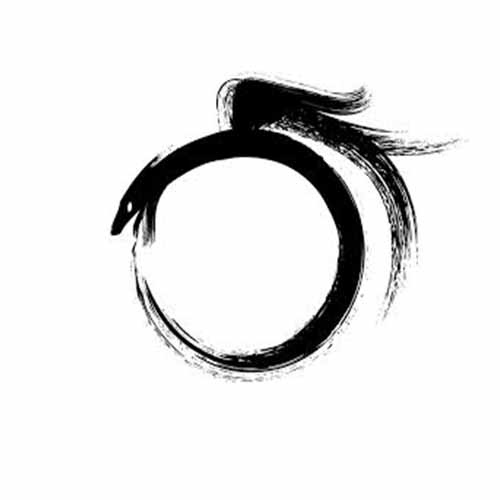The Heart Sutra: ” Form is the void and void is the form”
Ensos and the Ouroboros
“The alchemists, who in their own way knew more about the nature of the individuation process than we moderns do, expressed this paradox through the symbol of the Ouroboros, the snake that eats its own tail. The Ouroboros has been said to have a meaning of infinity or wholeness. In the age-old image of the Ouroboros lies the thought of devouring oneself and turning oneself into a circulatory process, for it was clear to the more astute alchemists that the prima materia of the art was man himself. The Ouroboros is a dramatic symbol for the integration and assimilation of the opposite, i.e. of the shadow. This ‘feed-back’ process is at the same time a symbol of immortality, since it is said of the Ouroboros that he slays himself and brings himself to life, fertilizes himself and gives birth to himself. He symbolizes the One, who proceeds from the clash of opposites, and he therefore constitutes the secret of the prima materia which […] unquestionably stems from man’s unconscious.”
C.G Jung
Collected Works, Vol. 14 para. 513

Ensō
In Zen Buddhism, an ensō (円相, , “circle”) is a circle that is hand-drawn in one or two uninhibited brushstrokes to express a moment when the mind is free to let the body create.
The ensō symbolizes absolute enlightenment, strength, elegance, the universe, and mu (the void).
The Heart Sutra
The Heart Sutra (The Prajnaparamita-Hrdaya Sutra):
When Bodhisattva Avalokitesvara practised the deep Prajnaparamita, he saw that the five skandhas were empty; thus he overcame all ills and suffering.
“O Sariputra! Form does not differ from the void, and the void does not differ from the form. Form is the void, and the void is form. The same is true for feelings, conceptions, impulses and consciousness.
O Sariputra, the characteristics of the void is not created, not annihilated, not impure, not pure, not increasing, not decreasing,
Therefore, in the void there are no forms and no feelings, conceptions, impulses and no consciousness: there is no eye, ear, nose, tongue, body or mind; there is no form, sound, smell, taste, touch or idea; no eye elements, until we come to no elements of consciousness; no ignorance and also no ending of ignorance, until we come to no old age and death; and no ending of old age and death.
Also, there is no truth of suffering, of the cause of suffering, of the cessation of suffering or of the path. There is no wisdom, and there is no attainment whatsoever. Because there is nothing to be attained, a Bodhisattva relying on Prajnaparamita has no obstruction in his heart.
Because there is no obstruction he has no fear, and he passes far beyond all confused imagination and reaches Ultimate Nirvana.
All Buddhas in the past, present and future have attained Supreme Enlightenment by relying on the Prajnaparamita. Therefore we know that the Prajnaparamita is the great magic Mantra, the great Mantra of illumination, it is the supreme Mantra, the unequaled Mantra which can truly wipe out all suffering without fail.
Therefore, he uttered the Prajnaparamita mantra, by saying:
“Gate, Gate, Paragate, Parasemgate Bodhi-svaha!”

Thank you!